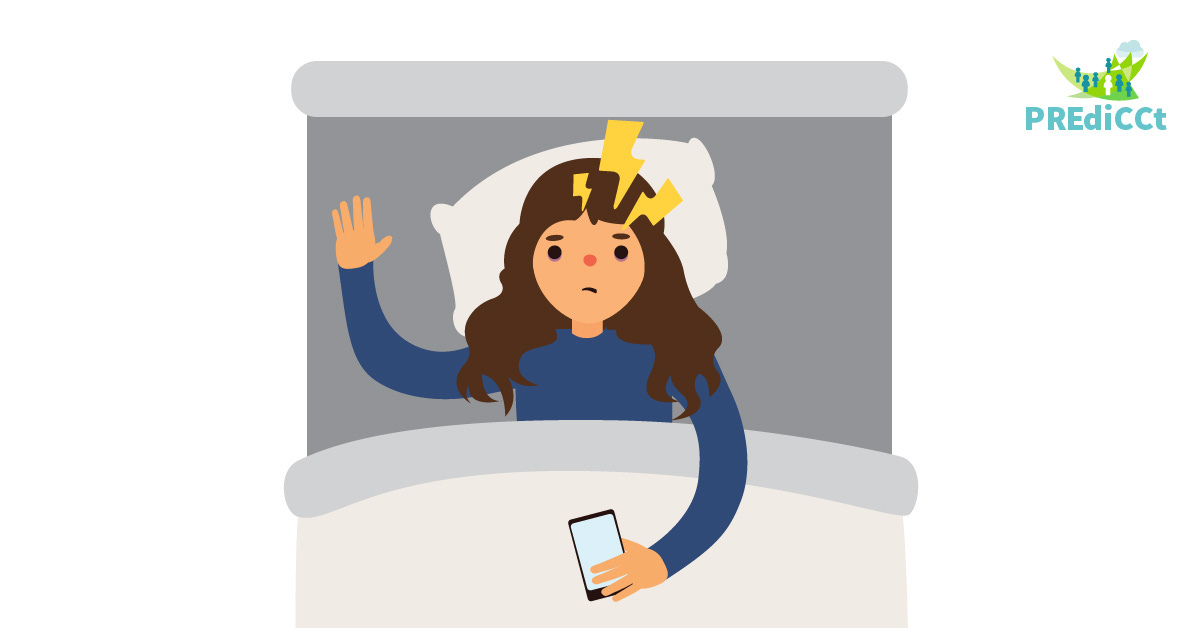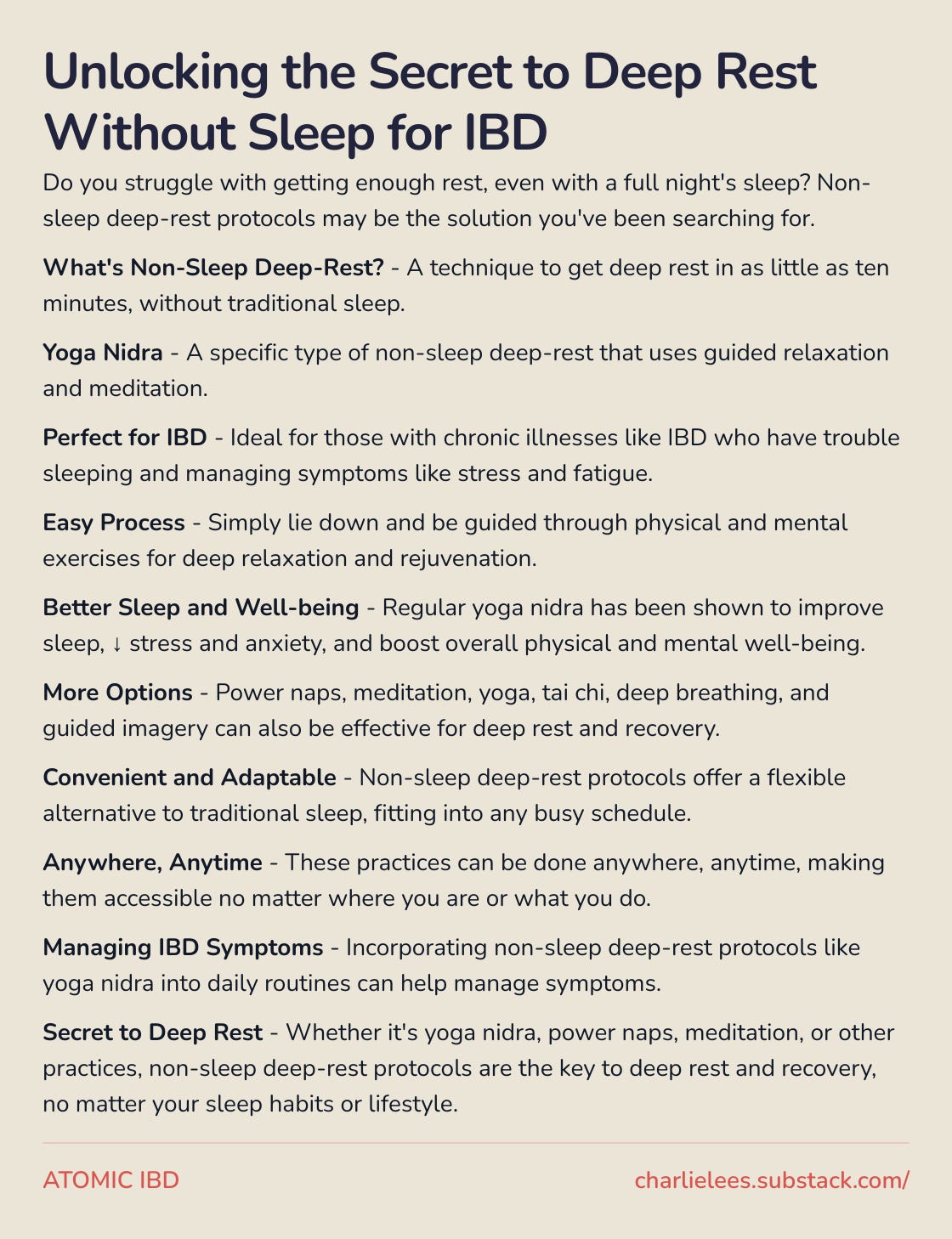Managing Sleep, Fatigue, and Mood in Patients with IBD
A guide for clinicians and patients with actionable tips and protocols
Welcome back to Atomic IBD.
Over the last 37 days I have been writing a publishing an atomic essay about IBD every day (Atomic IBD Essays). The last 5 have all been about energy management.
Fatigue and sleep disturbances are common issues for individuals with IBD. In this edition of Atomic IBD, we will be discussing different strategies for managing these symptoms and improving overall quality of life.
Today we are going to cover
understanding sleep issues in IBD
tips for a better night’s sleep with or without IBD
tools for improving energy and mood throughout the day
the power of non-sleep deep rest protocols in chronic illness
a guide to behavioural and pharmacological tools for fatigue with/ without insomnia
Understanding Sleep Issues in IBD
In the IBD clinic, I approach the issue of fatigue by asking two simple screening questions: "How is your sleep?" and "What are your energy levels like?" These provide a springboard for deeper questioning and listening.
By understanding the root cause of fatigue, it becomes easier to identify and address the issue.
Pain, diarrhoea and nausea are common symptoms overnight. Important note: nocturnal disturbance often signifies untreated gut inflammation. Check bloods and calprotectin.
Stoma issues are a frequent sleep disrupter - many can be solved with the help of an experience stoma nurse
Psychological health: is poor sleep a symptom of a depression or anxiety?


Tips for Better Sleep
Insomnia is a cruel mistress, with or without inflammatory bowel disease
Many of us don’t get enough quality sleep. I have spent the last 3 years tracking my sleep every night and testing different protocols in order to improve my sleep. There are a number of dedicated wearable devices available, either standalone or built into most smartwatches.
I use a Whoop band to track my sleep and exertion.
I also wear a Garmin Fenix 7 for my training - this has everything I need to monitor my efforts and keep me safe for days of trail running in the hills. I’ve previously used an Apple Watch, but I found that too intrusive and you have to charge it up almost every day. Both will do a great job of tracking sleep, but I don’t like to wear a watch overnight - an essential pre-requisite for sleep tracking!
The Whoop battery lasts 5 days and has not direct interface, both features I love.
The metrics I’m interested in following are:
hours in bed versus hours of sleep
sleep break down: awake, light, deep (slow wave) and REM (dream) sleep
consistency of bedtime and wake time (including at weekends)
resting heart rate and heart rate variability (Whoop measures these 30 minutes before waking each day to give a consistent reading)
From my own experience, these things trash my sleep:
Alcohol – even small quantities
Caffeine after midday
High anxiety
Getting up to pee
Eating too late in the evening
The impact of alcohol and caffeine is significantly greater than that of any other factor.
To improve sleep, my recommendations are a consistent bedtime and wake time, no alcohol, no caffeine after midday, last meal 2+ hours before bedtime, hydration throughout the day, exercise in the morning or middle of the day, journaling, a quiet, cool, and dark bedroom, and getting morning sunlight in your eyes.
Aim for 7-8 hours of sleep per night. This usually means 8-9 hours in bed.
10 tools for Improving Energy and Mood
In addition to managing IBD and treating any deficiencies, there are several other strategies for improving energy levels and mood.
Revising your diet, optimising sleep, getting exercise during daylight hours, screening for anxiety and depression, adjusting caffeine intake, practicing non-sleep deep rest protocols, and prioritising self-care can all help manage symptoms and improve well-being.
Non-Sleep Deep Rest Protocols
Yoga nidra has been a huge find for me over the past 6 months.
I try to maintain a short daily practice. Just 10 minutes offers a moment of deep rest and relaxation that leaves me feeling re-energised. At weekends I will often do a slightly longer session, but never longer than 30 minutes.
Personally I find this practice much easier and more rewarding than taking a power nap or a siesta.
Non-sleep deep rest protocols, such as yoga nidra, meditation, tai chi, deep breathing, and guided imagery, can provide deep rest and recovery without traditional sleep. These practices can be done anywhere, anytime, making them accessible no matter where you are or what you do. Incorporating non-sleep deep rest into your daily routine can help manage symptoms and improve overall well-being.
There is some literature on the benefit of non-sleep deep rest for people living with a chronic illness, such as IBD.
Here are a few examples of non-sleep deep-rest recordings to get you started:
Yoga Nidra recordings on YouTube: There are many free yoga nidra recordings available on YouTube, which can provide a simple and accessible introduction to the practice.
Insight Timer app: Insight Timer is a popular meditation app that offers a wide range of guided meditations, including yoga nidra recordings.
Mindfulness / mediation apps: Calm, Balance, Waking Up, Headspace, Insight Timer are popular meditation apps that offers a variety of mindfulness and relaxation exercises, including guided napping sessions.
Deep Relaxation recordings on Audible: Audible has a collection of deep relaxation recordings, including yoga nidra, that can be purchased or streamed.
These are just a few examples of the many non-sleep deep-rest recordings that are available online. It is important to note that these recordings may vary in quality and content, and individuals should carefully evaluate their suitability before using them. Nevertheless, these recordings can be a useful tool for individuals who are interested in exploring non-sleep deep-rest protocols, such as yoga nidra.
Managing Fatigue with a Combination of Interventions
Fatigue may be alleviated through a combination of pharmacological and non-pharmacological measures, under the supervision of a specialist.
For fatigue with insomnia, non-pharmacological interventions such as limiting alcohol and caffeine intake, spending time in early morning sunlight, and increasing physical activity during the day can be helpful. For fatigue without insomnia, correcting medical causes, avoiding "boom and bust" cycles of energy, and considering the use of non-sedative antidepressants may be necessary. Some interventions should only be used under the supervision of a specialist.
Fatigue with Insomnia
Non-Pharmacological Interventions
1 Minimise alcohol consumption
2 Spend time viewing early morning sunlight (5-10 minutes on clear days; 25-30 minutes on cloudy days)
3 Limit caffeine intake to mornings, and wait 90 minutes after waking
4 Increase pressure on sleep by ↑physical activity during the day
Pharmacological Interventions
• Consider taking mirtazepine 15mg at night, with higher doses of 30-45mg if depression is also present
• Promethazine 25-50mg at night may be helpful as a sedative antihistamine
• Avoid using Z-drugs and benzodiazepines
Fatigue without Insomnia
• Correct any medical causes of fatigue
• Avoid "boom and bust" cycles of energy
• Consider using a non-sedative antidepressant (SSRI or SNRI) if appropriate
• Specialist interventions may include high-dose thiamine, brupropion, reboxetine, and aripiprazole
Some of these interventions should only be used under the supervision of a specialist. Many are not yet standard practice or written into guidelines.
I hope this newsletter has provided valuable information on managing sleep, fatigue, and mood in IBD. As always, please consult with your IBD team for personalised advice and treatment options.





